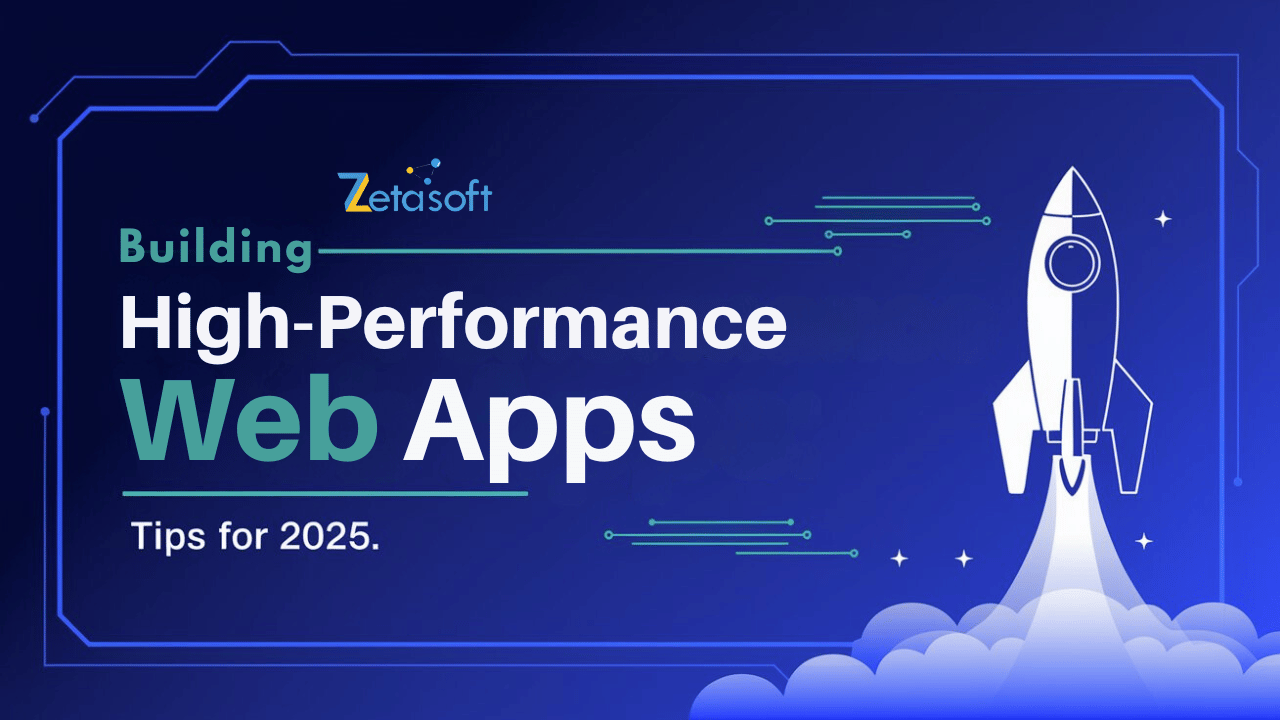As web applications grow to be indispensable tools for business organizations, performance remains central to users’ experience. Realization shows that performance is not only relevant to the satisfaction of users, but also for the purpose of SEO, CTR, and business outcomes. Indeed, as the technology and consumers’ expectations grow, web developers have to apply strict hi-tech approaches that would provide an application to achieve as high speed and stability as possible. In this article, we’ll discuss the most significant strategies to implementing for Building High-Performance Web Apps by 2025.
Optimizing for Speed with Modern JavaScript Frameworks

In the Building High-Performance Web Apps, JavaScript frameworks are used extensively in constructing web applications with interactivity and functionality but proper selection of the framework or platform and how to manage it effectively influence the performance aspect of the application.
Choosing Lightweight Frameworks
When we look at what will happen in 2025 there will be more preference for lightweight frameworks which take less time to load and requires fewer system resources. Libraries such as Svelte and Alpine are progressively being adopted because of lower overhead and higher efficiency compared to conventional big platforms. Both these frameworks restrict the usage of JavaScript code to a certain extent help in creating high speed applications that provide a good interface to the user.
Code Splitting and Lazy Loading
Code splitting and lazy loading minimize the quantity of content that must be loaded at one go while awaiting the rest of the information that comprises the application. It becomes possible to split the code and load them independently as chunks thus making the initial page load faster. It applies especially to the complex applications whereby the code splitting and the lazy loading guarantee the users, the best user interface as they explore the extensive feature of the application.
Minimizing JavaScript and CSS Files
Reducing JavaScript and CSS files is making unnecessary code deletions and also compressing the files to help reduce loading time. There are tools for various programming languages, such as Terser for JavaScript and PurgeCSS for CSS which can optimize I code base, and increase the app speed while minimizing the number of server requests. By the year 2025, developments in lightweight and minimized code will define high-performance web applications.
Leveraging Edge Computing and Serverless Architectures

One of the criteria For The Building High-Performance Web Apps, that define the performance of the application is how data is processed and served. The paradigm shift in web applications is being driven by Edge computing and Server less architectures which is about spreading data at edge and doing away with complex server structures.
Implementing Edge Computing for Faster Data Access
Also known as fog computing, edge computing decentralizes data processing by bringing the server closer to the end-user’s vicinity thus increasing the architectural speed. CDNs with edge capabilities general make developers deliver data form the closest source in other to reduce time taken. Thus, in 2025, edge computing will be a significant factor for those applications that require high performance, such as e-commerce marketplaces and real-time services to improve response time and the ability to scale.
Exploiting Serverless Functions for Scalability
Serverless functions let a developer write backend code that can be executed in the cloud and doesn’t have to arrange servers themselves. This approaches is best suited for tasks such as form submission, database queries and API requests as serverless functions self-provision in terms of computing. In high I/O web application, server-less architecture enhances performance and lead to lighter overhead since the function runs based on events. By 2025, serverless architectures will remain part of application high-performance solutions using cloud providers, such as AWS Lambda and Google Cloud Functions.
Reducing Latency with API Gateway
API gateways are used for solving performance issues because they act as intermediaries and filters between frontend and backend service requests. They allow developers to minimize the response time by storing results and the subsequent transfer of data. By 2025, API gateways will play a pivotal role in delivering fast, secure, and reliable API interactions, helping web apps respond quickly to user requests and ensuring a seamless experience.
Prioritizing User Experience with Performance-Driven Design

In Building High-Performance Web Apps, Web design and website performance are always interrelated in case of the companies involved in web development. A performance-oriented design strategy guarantees that all measures entail a swift utilization experience.
Designing Minimalistic Interfaces
One of the most important advantages of online minimalism it is the concentration of main content and exclusion of anything that might distract the user attention. Therefore, when implementing few graphical assets it is possible to decrease the quantity of the graphical assets that the browser interprets and thus get better performance. In 2025 minimalist design principles will be applied on high performance web apps, with uncluttered layout and minimal use of resources to create smooth user interaction.
Optimizing Images and Videos
Depending on the design and content of the web page, images and videos can easily become the largest objects on a page, and, as a result, their optimization is important to keep a site running smoothly. Some of these include; compressing, resizing and the use of sustainable formats such as next-generation image formats like WebP. The desire for highly optimized images and videos will remain high in the upcoming years: by 2025, every tool used in web development will include the option of optimizing images or videos to load in even low connection speeds.
Prioritizing Above-the-Fold Content
A visible content area is the area that can be viewed before scrolling the page up or down – the above-the-fold content. Making this content load first can enhance obtained performance since the part that users are most likely to consider first will indeed take a fraction of a second to load. When it comes to images or any other less pertinent content below the fold, then implementing lazy loading makes above the fold content to load faster. That way, this approach will be critical in the development of responsive, high-performance applications in 2025.
Enhancing App Responsiveness with Progressive Web App (PWA) Features

From The Building High-Performance Web Apps, Progressive Web Apps (PWAs) are apps that are a cross between traditional mobile applications and websites, designed for speed. Depending on the specialty, they can find that PWA features can enhance performance, engagement as well as accessibility.
Enabling Offline Access with Service Workers
They are executables that enable a PWA to operate when the network is weak or no connection is available. Caching resources and allowing offline setup are a few of the ways that service worker makes the site faster and satisfying. In 2025 offline capabilities will become a core competency for optimal performance Web application, let users have access to content and Interact with the app even without Internet.
Adding App-Like Navigation and Smooth Transitions
PWAs share most of the features with traditional mobile applications, such as smooth transition and easy navigation. Drawing from app-like navigation teams; they incorporate swipe actions, animated navigation, full-screen operation; thus, engaging users in the more intuitive way. Overall satisfaction will be achieved in a high performance web app as a result of some transition that facilitates user engagement.
Implementing Push Notifications
One of the primary advantages of PWAs is that the latter can reach out to users to remind them to visit their site. In its right use, this feature can help to enhance the user retention and interaction rates. By 2025, well-optimized push notifications turned into an obligatory capability work applications with high efficiency, making it possible for businesses to send relevant, real-time messages that will not only invite users to interact but do not require additional resources and time to positively influence app’s performance.
Using AI and Machine Learning for Predictive Loading

In The Building High-Performance Web Apps, AI with help of machine learning can understand a probable behavior of the user, which means that the web application preload content or resources to give an impression of an application response being at once.
Preloading Content Based on User Behavior
Predictive loading refers to the previous case where one preloads content or assets which users are expected to request next. Machine learning techniques enable AI to discover a sequence of user’s actions, so which page or its component a user opened might be expected. From these resources, the loading of app can be decreased and also the time taken when transferring from one application to the other can also be reduced hence increasing the smoothness.
Personalized Content Recommendations
Personalization recommendation can also be implemented using machine learning to increase client’s clan engagement, but at the same time decrease demand on servers. Web apps can enhance both relevance and effectiveness when user data are analyzed and content that corresponds to users’ interests is served. In a visionary way, recommender systems will enhance the user experience, so that the customers remain longer in the platform because they have been given the best possible way to navigate and use it.
Adaptive Image Loading
AI can improve image loading by delivering images in the appropriate size that is corresponding to the kind of device and availability of network. With adaptive image loading, images only adjust their quality and resolution with the necessary data used to load the image and cut down on load times. By 2025, AI adaptive image loading technique will be implemented in engineered high load applications, so, all visitors using different devices with different connection speed will have fast and very beautiful images and graphics.
Implementing Robust Security without Sacrificing Performance

In Building High-Performance Web Apps, Security is very important when it comes to web development but in most cases it results to loss of performance. Security best practices will be implemented into high-performance web apps in 2025, thus not affecting the performance of the apps.
Using HTTPS and Secure Protocols
Employing HTTPS helps secure the data exchange between the user interface and the server since it only ensures that there is a better and faster way of transmitting data. Today, it is very important to have an https:// for your site since many search engines rank sites that use https:// first. I am convinced that in 2025, HTTPS will be mandatory for essentially all high-performance Web applications, and it will bring not only the issue of security but also the advantage in the form of higher SEO indicators.
Implementing Caching Strategies for Secure Content
Some data should be addressed with caution especially when it comes to caches because caching strategies determine speed. In high-performance web apps, developers will employ intelligent caching that enables caching of common data, excluding the sensitive one. It reduces load times whilst also maintaining the security of the information that needs to be transferred.
Rate Limiting and Bot Protection
Still, the threats that are launched to congest the servers are crucial to attack, therefore, rate limiting, and bot protection are vital. Request limiting is used to prevent multiple requests from a particular IP, and helps to prevent DoS attacks. The application of CAPTCHA and reCAPTCHA is an efficient way of protecting the bots that cause a lot of overloading of resources. As a further-oriented strategy, these measures will be developed as integrated to secure the operations of the app while also protecting the performance from interference.
Emphasizing Sustainability and Energy Efficiency

By 2025 For The Building High-Performance Web Apps, there is going to be major emphasis on so-called sustainable web development paradigms as the companies seek to lessen their impact on the climate. Thus, the building of energy-efficient apps not only serves the concept of CSR but also empowers performance.
Reducing Resource Intensity
Web applications for everyday usage in the year 2025 will require considerably less resources like servers and bandwidth as the majority of them can perform complex operations using as fewer requests from Web servers as possible. This is in terms of code weight, media used for encoding and caching to ensure that the app uses minimal resources. To make apps more efficient developers need to design them so that they use fewer resources in operation, thus making them better while also being more sustainable.
Utilizing Green Hosting Providers
Green hosting suppliers rely on eco-friendly power sources and optimally efficient computer server infrastructures to decrease environmentally deprecatory impacts of www applications. When developers opt for green hosting, then they are promoting sustainability objectives in addition to enjoying efficient hosting services that support their high performing applications. In the future, green hosting will allow businesses to choose hosts who pay serious attention to sustainability in addition to great performance.
Implementing Energy-Efficient Code Practices
Specific coding practices in which computation is reduced, load time decreased, and unnecessary processes performed as rarely as possible also saves energy. There are common approaches, such as lazy loading, clean and lean databases, and efficient loops, which will help developers save energy consumption. By 2025, sustainable coding practices are set to become the best practice in fast web development and by extension fast app development for companies.
Summary
Creating powerful web applications in 2025 require bringing effective JavaScript frameworks, taking advantage of edge computing, focusing on the UX design approach, introducing PWA characteristics, applying AI for effective loading, considering security, and environmental issues. These strategies, when applied allow developers to design applications that are not only fast to react and responsive, but also, ready for the future and environmentally conscious. When users’ demands and new technologies appear, implementing these practices will be mandatory to create robust, high- performing web applications that will last long.

